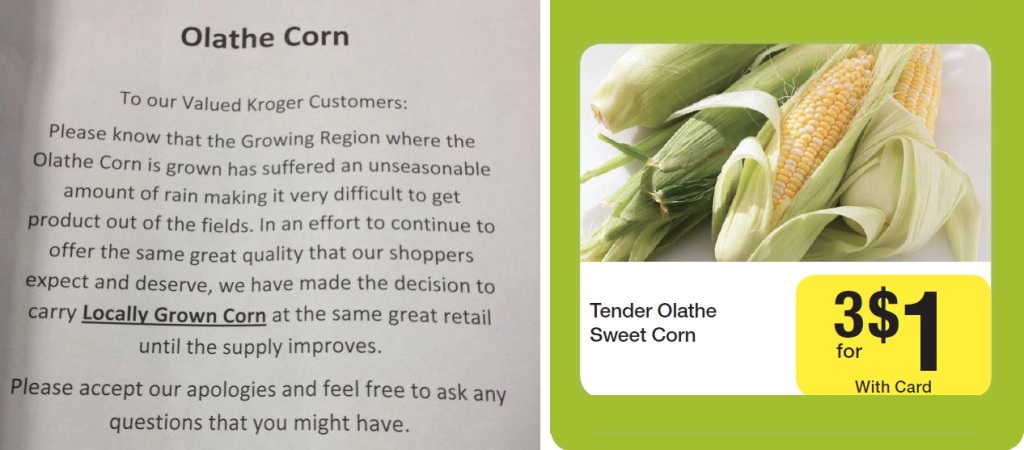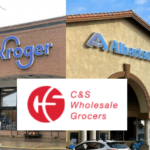It sounds like a satirical headline, but strangely, and sadly, it’s not. An incredulous Kroger shopper has taken to Facebook to ask why her store in Savannah, Georgia was apologizing for carrying locally-grown produce.
Isn’t locally-grown supposed to be a good thing? Or is the country’s largest grocery chain so used to getting its produce from far-flung places, that it buys local only as a last resort – and then feels the need to apologize for it?
“The growing region where the Olathe corn is grown has suffered an unseasonable amount of rain, making it very difficult to get product out of the fields,” read a sign posted in the store, as shared by the Kroger shopper. The sweet corn variety, grown in Olathe, Colorado, was recently advertised in Kroger’s weekly sales circular, at 3 for $1. But the store in Savannah apparently had a hard time getting it in stock. So, “in an effort to continue to offer the same great quality that our shoppers expect and deserve,” the sign continued, “we have made the decision to carry locally grown corn at the same great retail (price) until the supply improves. Please accept our apologies.”
Supporting local farmers by buying and selling their corn? How dare you, Kroger!
“Kroger, are you crazy?” asked the shopper who posted a picture of the sign on the store’s Facebook page. “Why would you apologize for locally grown corn? We would rather have locally grown corn!”
At least one recent survey suggests that most of us would rather have locally grown produce, if given the choice. The consulting firm A.T. Kearney reported earlier this year that 70% of the shoppers it surveyed said they would pay more for produce that was grown locally. The survey also found that most shoppers don’t trust national chains to offer truly local foods, and almost a third said they will buy what they need at their local grocery chain, but go somewhere else for their produce, if the chain store doesn’t carry local foods.
Some chains are taking notice of this trend. Regional retailers like Michigan-based Meijer and Wisconsin’s Roundy’s have recently pledged to offer more local foods. Last month, Roundy’s partnered with a farmers’ cooperative to offer Wisconsin-grown produce in its Pick ‘n Save stores, along with information about who grew the products and where. Meijer is promoting its local focus on social media (“Michigan apples have arrived!” it recently announced on Facebook). And earlier this year, as part of a plan to ensure fresher produce in its stores, Walmart announced that more of its food would be locally-sourced (read: “Return Your Rotten Food to Walmart – No Questions Asked!”).
But other big grocery chains, like Kroger and Safeway, have a different view of buying and selling locally. And they also have a different definition of “local”. Columbus, Ohio’s WOSU-FM reported recently that a display at a local Kroger store defined “local” as crops that are grown within a 400-mile radius. In 2011, the Wall Street Journal reported that Safeway’s policy is that produce is considered “local” if it’s within an eight-hour drive of the store.
To be fair, Kroger’s Michigan Division has been promoting its local produce, and recently announced a contest in which local shoppers can win free Michigan apples for a year. So the chain is not entirely averse to sourcing its food locally. Still, Kroger’s social media staff didn’t quite appear to understand the recent hubbub on the store’s Facebook page, over the Olathe corn. “We were simply apologizing because an advertised item was not in stock,” read Kroger’s sheepish reply to the shopper who couldn’t believe the sign she saw.
“Farmers market, here I come,” commented another shopper in response. They may not have Olathe-grown corn at the farmers market, but that’s okay – at least they’re not seeking your forgiveness for it.
Image source: Kroger/Facebook

















Living only 50 miles from Olathe and enjoying the fresh crop right now. Our Monsoons finally moved out after an extremely wet period this year. The corn is delicious. As far as I know, all corn we eat has been modified as it was merely a grass with small finger sized fruit originally. You wouldn’t even recognize it compared to today’s crop. Olathe sweet sweet corn is generally grown by some 9 varieties. Some all white and then some mixed white and yellow. All are super sweet. Some are claiming Organic and others non GMO, yet others have been modified to be insect resistant. I think you would have to go to all farms no matter what region of the country and ask the grower what they have. As far as Olathe sweet corn, I like the mixed colored species. If you’ve never eaten any you wouldn’t understand that there is a huge difference in flavor and sweetness. My mother in law visited a few years ago to Grand Junction. She has spent 60 years on her farm near Waterloo, IA. She proclaimed Olathe sweet corn possibly the best corn she’d ever eaten. Now that’s something to hear.
I Love Olathe Corn, My concern is for the GMO corn & the pesticides, artificial fertilizers & other junk that is used to raise crops & animals in the USA. Is there a site that would tell of the farms that are using these BAD PRACTICES? How many Olathe farms raise GMO corn?
some of the corn was really small but looks like it is getting better
DFW AREA
Lisa, you are absolutely correct. Fresh Olathe corn does taste better than any corn I’ve tasted – ever. It’s also non-GMO! I have tasted a lot of corn in my long lifetime. Olathe is the best.
Ok-wait a minnit. You know me-I see things differently… Please let me point out what’s REALLY wrong w/ this picture.
Think about this—> “the decision to carry locally grown corn at the same great retail (price)”
Since they seem to be implying that local corn is inferior AND since it’s local there’s lower shipping cost…shouldn’t the PRICE be LOWER? (and not the same ‘great’ retail price of that gourmet stuff?)
Barbee, the produce sold at my local farmers’ markets usually costs much more than what I normally pay at Kroger. The commercial farms that mass-produce our supermarket foods have much lower per-item cost than a small individual farm operation. I suspect the desirability of local produce has something to do with the pricing as well.
Thanks, Lisa for mentioning Farmers Markets. I’m a strong supporter.
As to the pricing at Farmer’s markets, I agree with you that there are a whole host of reasons why it would cost more:
Organic growing practices and (non-migrant) higher labor costs. Along w/ the less obvious but tangible benefits of mass operations: inability to receive Federal tax benefits, contractual pricing and shipping guarantees. PLUS the public perception that Farmers markets are ‘fresher and more healthful’. All of these factors support higher prices at Farmers Markets.
All that said. I did a quick internet search of “Olanthe” corn, it’s supposed to be special. Gourmet. Like the prime beef of corn. Is this true? (Because we pay more for prime beef-right?)Do you have any experience w/ Olanthe?
P.S. Corn in my area: Dallas, TX is running 4/$1 or 25cents/ea. What’s it going for in yours?
Barbee, here in north Mississippi (Memphis area), our Kroger stores often carry the Olathe corn at 3/$1. It is the sweetest corn I have ever eaten. The availability this year has been spotty. We eat corn on the cob (cooked in the husk in the microwave) once or twice a week during the summer.
I, too, love the farmers’ markets. I buy tomatoes, okra, eggplant and yellow squash almost weekly, but I go to Kroger for the corn!
I just bought several dozen as we get trucks that pick up the crop daily as it is picked from the field and sell right off the street here in Grand Junction, a mere 50 mile drive. Because of the freshness, the sugar in the corn is off the chart. Right now we have temps in the mid to upper 90’s and night time temps in the mid 50’s in Olathe. This forces the sugars to go wild in the kernels. I pay $3.50 a dozen for the pleasure of super fresh. No store sells it like that as it takes days if not over a week to get it on the shelf. Each day the sugar turns to starch more and more. Fresh is the experience and you have to be here to experience it. So, next time in Colorado, come see all the great out door fun we have here in Grand Junction and all the fruit and vegetables we have during August. Thursday is the down town farmer’s market festival each week with live music and vendors. Downtown is closed off to traffic so its a pedestrian pleasure that day. It is also peak peach season and I won’t start on that as we have some of the best you’ve ever eaten.
I understand Kroger’s apology completely. I live in north Mississippi and our local corn doesn’t taste nearly as good as the Olathe corn Kroger regularly sells. I have had some locals try to pass off their field corn as sweet corn and even the local sweet corn can’t compare to the Olathe corn. To each his own, I guess!